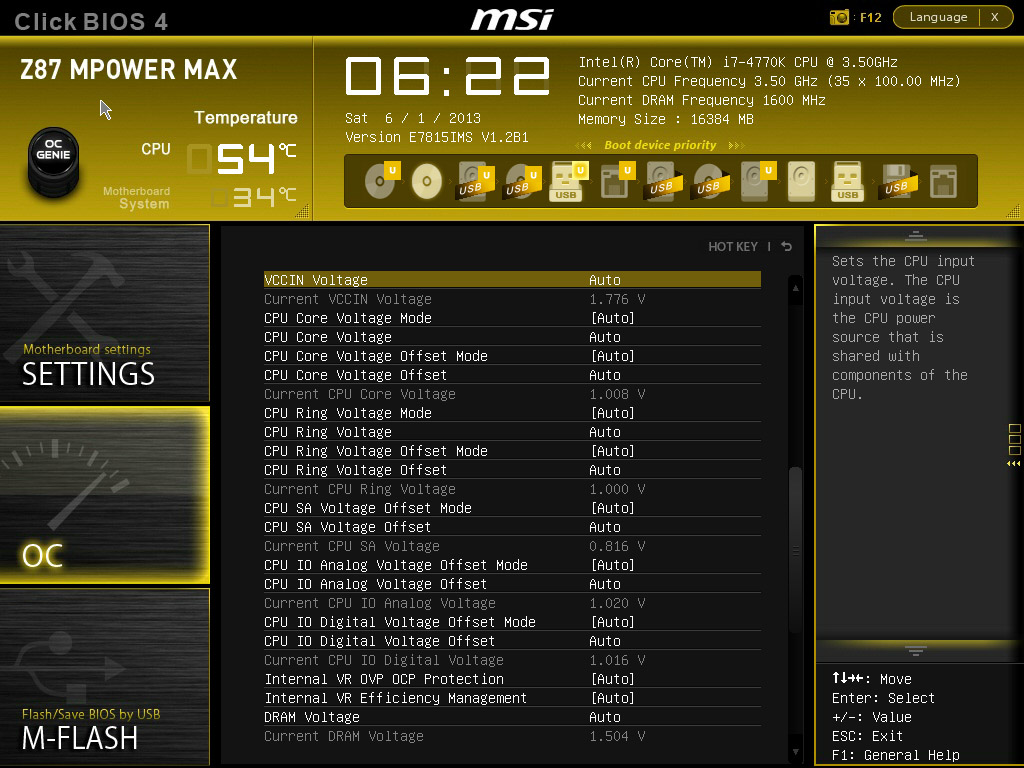The Core i7-4770K Review: Haswell Is Faster; Desktop Enthusiasts Yawn
Intel's Haswell architecture is finally available in the flagship Core i7-4770K processor. Designed to drop into an LGA 1150 interface, does this new quad-core CPU warrant a complete platform replacement, or is your older Sandy Bridge-E system better?
Overclocking Haswell: You’ll Pay For That
If you purchase one of the two K-series parts in Intel’s Haswell-based portfolio (and you have a Z87-based motherboard), you’ll have access to the same knobs and dials that were available from the Core i7-3770K and i5-3570K, with one notable change: the BCLK ratios popularized by X79 Express are back, facilitating some manipulation of the number that gets multiplied against the clock ratio. Intel exposes 1.0x, 1.25x, 1.67x, and 2.5x straps.
There’s a colossal difference between what Haswell-based LGA 1150 processors can do in theory, and what they can do after Intel’s product guys get done disabling the bits and pieces to create a differentiated stack, though.
Overclockers maintain control over core frequency using ratios up to 80x in 100 MHz increments. The on-die graphics engine is also adjustable in 50 MHz increments via ratios as high as 60x. Further, the memory controller is technically unlocked, allowing options for 200 and 266 MHz steps with a logical ceiling at 2,933 MT/s. Finally, the platform controller hub’s clock generator is unlocked too, supporting frequencies as high as 200 MHz.
But as with generations past, there remains a relationship between the DMI clock and PCI Express clocks—and you want PCI Express to stay as close to 100 MHz as possible. So, Intel implements 5:5, 5:4, 5:3, and 5:2 ratios to maintain constant PCIe clocks with a variable BCLK. Unlike the LGA 2011 platform, which used the CPU to adjust those ratios, Haswell requests this from the PCH. The outcome is similar, though. Expect a useable range between 5-7% around the ratio you choose for fine-tuning your overclock.
That’d all be well and good if Intel was enabling this new level of flexibility for the folks who don’t spend extra on K-series parts, giving them the ability to pick higher BCLK settings without access to the ratio multiplier. However, the company instead chooses to restrict the ratios to the Core i7-4770K and i5-4670K—the same ones you can already overclock in 100 MHz increments. Anyone buying one of the 11 other SKUs in Intel’s new Core i7 and i5 line-up is out of luck.
Overclocking Core i7-4770K
Moving on, what can you expect from a Core i7-4770K, in terms of overclocking headroom? We have a couple in the lab, and are getting 4.7 GHz, at most, across all cores using Prime95 to test for stability. However, those samples come from Intel. We were much more interested in feedback from someone with many, many retail parts at their disposal.
Get Tom's Hardware's best news and in-depth reviews, straight to your inbox.
Our first-hand information involves a high double-digit number of processors, including samples and final shipping boxed CPUs. Sort testing was limited to 1.2 V to keep heat manageable. Ring/cache ratios are pegged at 3.9 GHz, with the memory controller operating at 1,333 MT/s. Of the chips available for sorting, only one is stable at 4.6 GHz under full load. A few are capable of operating at 4.5 GHz. More run stably at 4.4 GHz. Most are solid at 4.3 GHz and down. As you stretch above a 1,600 MT/s memory data rate or a ring ratio to match your highest single-core Turbo Boost ratio (which helps maximize performance), your top stable core frequency tends to drop.
Load-line calibration has very little, if any, effect with Haswell. There’s simply less flexibility to coax a killer overclock out of one of these CPUs using levers that were popular previously. Although the most enthusiast-friendly motherboards still include pages of options, a number of them simply don’t do anything beneficial. Flatly, it sounds like engineers and enthusiasts alike are still trying to figure out what the more obscure settings actually do.
We’re going to have to accept that Haswell-based parts get hotter, faster, it sounds like, and that they might fall a few hundred megahertz short of comparable Ivy Bridge-based parts with conventional cooling methods. It’s a good thing, then, that the architecture is inherently faster to help compensate.
Current page: Overclocking Haswell: You’ll Pay For That
Prev Page Intel 8-Series Chipsets: Z87 Is Nice Next Page Test Setup And Benchmarks-
Danny N Biggest question is if its worth upgrading my cpu i5 750 4.0ghz to Haswell or my gfx card ati 5870 to nvidia 7xx, my main pc use is for Maya, After FX and some fps gaming. Any input would be appriciated cause I'm leaning towards a cpu upgrade atm.Reply -
refillable @Danny NReply
You shouldn't ask here. Perhaps you should get an i7-4770k and a 7970(?) I heard that kepler cards does not perform that good in Maya and Aftereffects (In OpenCL). -
envy14tpe Seriously. What did people expect? Of course it's better but nothing out of the ordinary for Intel.Reply -
enewmen For me it's not about the 10% gain over SB. It's more like a huge gain over a C2Q, floating point performance over SB (should matter later), and lower watts. I hope THG can expand the Power Consumption and Media Encoding later - check the Watts idle more and fast quick-sync media encoding quality loss. My 2 cents..Reply
EDIT:
other sites have reported much lower watts idle, so a lot doesn't make sense or the 4770k has a very slow throttle.
http://hexus.net/tech/reviews/cpu/56005-intel-core-i7-4770k-22nm-haswell/?page=15
http://www.techspot.com/review/679-intel-haswell-core-i7-4770k/page13.html





